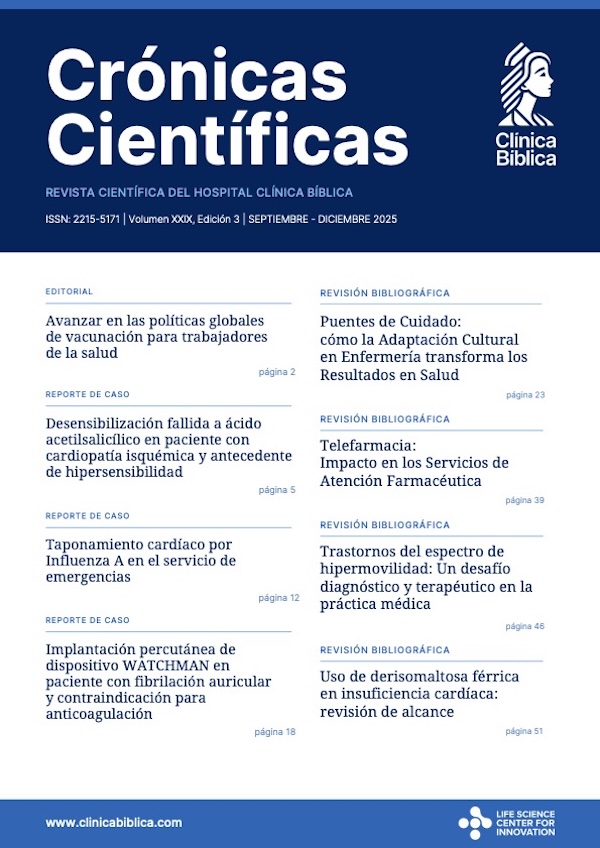- Visto: 1289
Revisión Bibliográfica
Tratamiento del síndrome nefrótico en pedriatría
Treatment of nephrotic syndrome in pediatrics
Edición XVII Enero - Abril 2021
DOI: https://doi.org/10.55139/AUYM1449
APA (7ª edición)
Villalobos-Alvarado, G., Castillo-Jiménez, A., Gallo-Durán, S. (2020). Tratamiento del síndrome nefrótico en peditría. Crónicas científicas, 17(17), 53-63. https://doi.org/10.55139/AUYM1449.
Vancouver
Villalobos-Alvarado G, Castillo-Jiménez A, Gallo-Durán S. Tratamiento del síndrome nefrótico en peditría. Cron cient. 30 de noviembre de 2020; 17(17): 53-63.
Dra. Gloriana Villalobos Alvarado
Médico general.
Licenciatura en Medicina y Cirugía, Universidad de Ciencias Médicas (UCIMED), San José, Costa Rica.
Miembro del Colegio de Médicos y Cirujanos de Costa Rica.
Médica de Empresa para Soluciones Efectivas, San José, Costa Rica.
Dra. Alina Castillo Jiménez
Médico general.
Licenciatura en Medicina y Cirugía, Universidad de Ciencias Médicas (UCIMED), San José, Costa Rica.
Miembro del Colegio de Médicos y Cirujanos de Costa Rica. Médica trabajadora independiente, San José, Costa Rica.
Dra. Sofía Gallo Durán
Médico general.
Licenciatura en Medicina y Cirugía, Universidad de Ciencias Médicas (UCIMED), San José, Costa Rica.
Miembro del Colegio de Médicos y Cirujanos de Costa Rica.
Médica trabajadora independiente, San José, Costa Rica.
Resumen
El síndrome nefrótico idiopático es la enfermedad renal glomerular más frecuente en la edad pediátrica, cuya lesión más común es la enfermedad de cambios mínimos. Se caracteriza por la presencia de proteinuria en rango nefrótico, hipoalbuminemia (ambas deben estar presentes), edema e hiperlipidemia. La mayoría de los pacientes responden al tratamiento con esteroides, sin embargo, un porcentaje de estos pacientes son resistentes a estos, haciéndolos más susceptibles a complicaciones, como la enfermedad renal crónica, la cual se desea evitar. Además, es importante dirigir la terapia hacia otras manifestaciones clínicas como la hipercoagulabilidad, el riesgo aumentado de infecciones y el edema. Este artículo se enfoca en el tratamiento de esta patología, con el objetivo de aportar información útil para profesionales de la salud, quienes podrán comprender la importancia de identificar el manejo adecuado, clasificar al paciente según la respuesta al tratamiento y dirigir una terapia óptima.
Palabras claves
Síndrome nefrótico, esteroides, pediatría, proteinuria, hipoalbuminemia.
Abstract
Idiopathic nephrotic syndrome is cataloged as the most frequent renal disease in children. This syndrome is characterized by minimal change disease, which means proteinuria and hypoalbuminemia are symptoms which are found in these patients, edema and hyperlipidemia are often accompanying symptoms. The majority of patients with idiopathic nephrotic syndrome will respond to steroid treatment, nevertheless, a percentage of this patients are resistant to such treatment. These patients have a higher susceptibility to long term complications like chronic kidney disease. Therefore, it is important to highlight the significance of the proper handling of each patient, as well as the treatment of other clinical manifestations such as hypercoagulability, edema, and increased infection risks in these patients. The following article therefore emphasizes the treatment of this disease so that health care professionals can identify the type of patient and the optimal treatment.
Keywords
Nephrotic syndrome, steroids, pediatrics, proteinuria, hypoalbuminemia.
Bibliografía
Alcívar-García, M. (2019). Síndrome nefrótico a revisión de un caso. Dominio de las Ciencias, 5(3), 434-442. https://doi.org/10.23857/ dc.v5i3.944.
Anigilaje, E., Fashie, A. y Ochi, C. (2019). Childhood nephrotic syndrome at the University of Abuja Teaching Hospital, Abuja, Nigeria: a preliminary report supports high steroid responsiveness. Sudanese Journal of Paediatrics, 19(2), 126-139. https://doi. org/10.24911/SJP.106-1547399573.
Azocar, M., Vega, Á., Farfán, M. y Cano, F. (2016). Identificación de variantes del gen NPHS2 en niños con síndrome nefrótico corticorresistente. Revista Chilena de Pediatría, 87(1), 31-36. http://dx.doi.org/.1016/j. rchipe.2015.06.025.
Borovitz, Y., Alfandary, H., Haskin, O., Levi, S., Kaz, S., Davidovits, M., Dagan, A. (2019). Lower prednisone dosing for steroid-sensitive nephrotic syndrome relapse: a prospective randomized pilot study. European Journal of Pediatrics, 179(2), 279-283. https://doi. org/10.1007/s00431-019-03506-5.
Choudhry, A., Bagga, A., Menon, S., Hari, P. (2007). Randomized controlled trial (RCT) on efficacy and safety of cyclosporin (CyA) vs tacrolimus (Tac) in steroid resistant nephrotic syndrome (SRNS). Pediatric Nephrology, 22(9), 1480. https://doi.org/doi: 10.1053/j. ajkd.2008.11.033.
Dogra, S. y Kaskel, F. (2016). Steroid-resistant nephrotic syndrome: a persistent challenge for pediatric nephrology. Pediatric Nephrology, 32(6), 965-974. https://doi.org/10.1007/ s00467-016-3459-5.
Downie, M., Gallibois, C., Parekh, R. y Noone, D. (2017). Nephrotic syndrome in infants and children: pathophysiology and management. Paediatrics and International Child Health, 37(4), 248-258. https://doi.org/10.1080/2046 9047.2017.1374003.
Hevia, P., Nazal, V., Rosati, M., Quiroz, L., Alarcón, C., Márquez, S. y Cuevas, K. (2015). Síndrome nefrótico idiopático: recomendaciones de la Rama de Nefrología de la Sociedad Chilena de Pediatría. Parte 1. Revista Chilena de Pediatría, 86(4), 291-298. https://doi.org/10.1016/j.rchipe.2015.05.005.
Jellouli, M., Charfi, R., Maalej, B., Mahfoud, A., Trabelsi, S. y Gargah, T. (2018). Rituximab in The Management of Pediatric SteroidResistant Nephrotic Syndrome: A Systematic Review. The Journal of Pediatrics, 197, 191-197. https://doi.org/10.1016/j.jpeds.2018.01.008.
Liu, I., Willis, N., Craig, J. y Hodson, E. (2019). Interventions for idiopathic steroid-resistant nephrotic syndrome inchildren. Cochrane Database of Systematic Reviews, 2019(11), CD003594. https://doi. org/10.1002/14651858.CD003594.pub6.
Niaudet, P. (2018a). Etiology, clinical manifestations, and diagnosis of nephrotic syndrome in children. Uptodate.com. Recuperado de https://www.uptodate.com/ contents/etiology-clinical-manifestationsand-diagnosis-of-nephrotic-syndrome-inchildren?search=nephrotic%20syndrome%20 in%20children&source=search_result&select edTitle=1~150&usage_type=default&display_ rank=1.
Niaudet, P. (2018b). Symptomatic management of nephrotic syndrome in children. Uptodate.com. Recuperado de https:// www.uptodate.com/contents/symptomaticmanagement-of-nephrotic-syndrome-inchildren?search=nephrotic%20syndrome%20 in%20children&source=search_result&select edTitle=4~150&usage_type=default&display_ rank=4. Niaudet, P. (2019). Treatment of idiopathic nephrotic syndrome in children Uptodate.com. Recuperado de https://www.uptodate.com/ contents/treatment-of-idiopathic-nephroticsyndrome-in-children?search=nephrotic%20 syndrome%20in%20children&source=search_ result&selectedTitle=2~150&usage_ type=default&display_rank=2.
Noone, D., Iijima, K. y Parekh, R. (2018). Idiopathic nephrotic syndrome in children. The Lancet, 392(10141), 61-74. https://doi. org/10.1016/S0140-6736(18)30536-1.
Pasini, A., Benetti, E., Conti, G., Ghio, L., Lepore, M., Massella, L., Molino, D., Peruzzi L., Emma, F., Fede, C., Trivelli, A., Maringhini, S., Materassi, M., Messina, G., Montini, G., Murer, L., Pecoraro, C. y Pennesi, M. (2017). The Italian Society for Pediatric Nephrology (SINePe) consensus document on the management of nephrotic syndrome inchildren: Part I - Diagnosis and treatment of the first episode and the first relapse. Italian Journal of Pediatrics, 43, 41. https://doi. org/10.1186/s13052-017-0356-x.
Mai, S., Kenji, I., Takashi, A., Kaori, K., Chikako, T., Riku, H., Shingo, I., Yuko, H., Yoshinori, A., Yoshimitsu, G., Koichi, N., Hitoshi, N., Takeshi, M., Kazumoto, I., Norishige, Y., Shuichi, I., Masataka, H. (2019). Prognosis and acute complications at the first onset of idiopathic nephrotic syndrome in children: a nationwide survey in Japan (JP-SHINE study), Nephrology Dialysis Transplantation, gfz185. https://doi. org/10.1093/ndt/gfz185.
Stone, H., Magella, B. y Bennett, M. (2019). The Search for Biomarkers to Aid in Diagnosis, Differentiation, and Prognosis of Childhood Idiopathic Nephrotic Syndrome. Frontiers in Pediatrics, 7, 404. https://doi.org/10.3389/ fped.2019.00404
Trautmann, A., Schnaidt, S., Lipska-Zietkiewicz, B., Bodria, M., Ozaltin, F., Emma, F. Anarat, A., Melk, A., Azocar, M., Oh, Y., Saeed, B., Gheisari, A., Caliskan, S., Gellermann, J., Serna, M., Jankauskiene, A., Drozdz, D., Mir, S., Balat, A., Szczepanska, M., Paripovic, D., Zurowska, A., Bogdanovic, R., Yilmaz, A., Ranchin, B., Baskin, E., Erdogan, O., Remuzzi, G., Firszt-Adamczyk, A., Kuzma-Mroczkowska, E., Litwin, M., Murer, L., Tkaczyk, M., Jardim, H., Wasilewska, A., Printza, N., Fidan, K., Simkova, E., Borzecka, H., Staude, H., Hees, K., Schaefer, F. (2017). LongTerm Outcome of steroid-resistant nephrotic syndrome in children. Journal of the American Society of Nephrology, 28(10), 3055-3065. https://doi.org/ 10.1681/ASN.2016101121.
APA (7ª edición)
Villalobos-Alvarado, G., Castillo-Jiménez, A., Gallo-Durán, S. (2020). Tratamiento del síndrome nefrótico en peditría. Crónicas científicas, 17(17), 53-63. https://doi.org/10.55139/AUYM1449.
Vancouver
Villalobos-Alvarado G, Castillo-Jiménez A, Gallo-Durán S. Tratamiento del síndrome nefrótico en peditría. Cron cient. 30 de noviembre de 2020; 17(17): 53-63.
Esta obra está bajo una licencia internacional Creative Commons: Atribución-NoComercial-CompartirIgual 4.0 Internacional (CC BY-NC-SA 4.0)

Realizar búsqueda
Última Edición
Ediciones Anteriores






